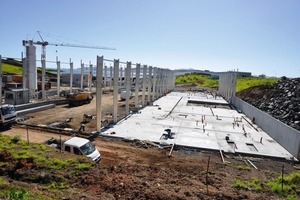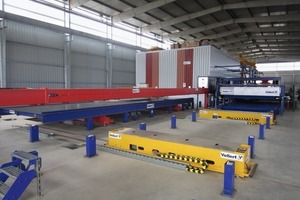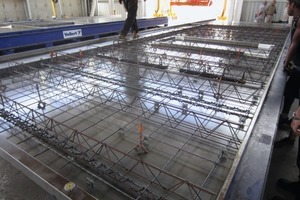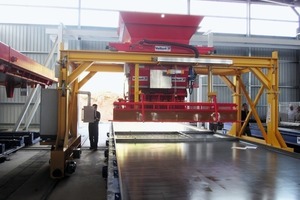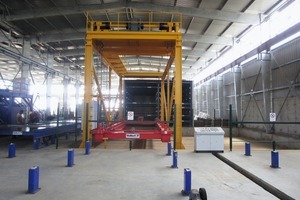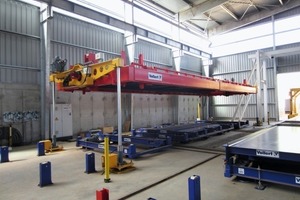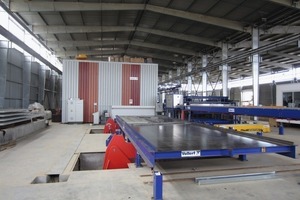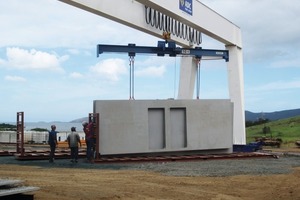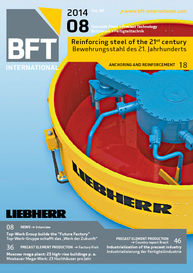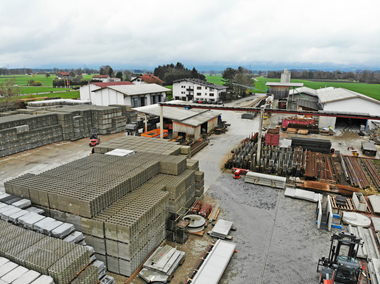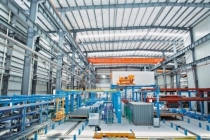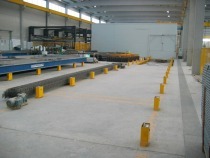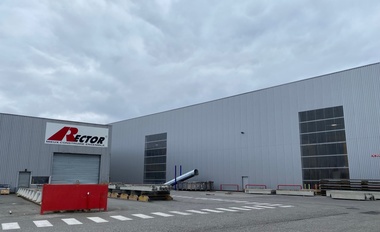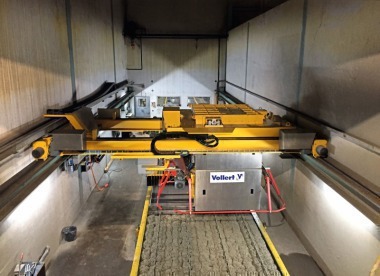New Caledonians count on precast
Construction of the new plant of the New Caledonian LBDP Group was completed in April 2014. It is to produce precast floor slabs and double and sandwich walls, as well as girders and columns for hall-type buildings.
In New Caledonia, a group of French islands in the South Pacific, precast is being used extensively to construct new residential and public buildings, but also to initiate new projects in the tourism industry. The aim is to construct architecturally appealing detached houses and multi-story residential buildings, as well as hospitals, schools, complete hotel facilities and factory buildings.
For this project, LBDP (Les Betons du Pacifique) Group selected the internationally active MC2 design office as its partner providing the required expertise. Vollert Anlagenbau GmbH, from Weinsberg, Germany, was chosen as an experienced engineering partner and technology supplier. As early as in the planning and design phase, Vollert used 3D simulation and costing models to develop various scenarios and flexible proc-esses aligned with the production mix that comprises extensive and structural precast elements. “The most commercially viable solution will always be tailor-made depending on the types of precast elements to be produced, the required output, the degree of automation and the total capital expenditure,” explains Philippe Marrié, senior sales engineer at Vollert.
State-of-the-art production line and circulation technology ensure efficient processes
In the start-up phase, up to 15 formwork pallets are continuously routed through the semi-automatic circulation system. The new production line is to achieve an annual output of up to 100,000 m² of non-prestressed precast floor slabs and double/sandwich wall units. “For this purpose, we relied on state-of-the-art equipment and exceedingly robust, reliable machines that require only very little maintenance. This principle applies to various stages, including the preparation of the formwork, concrete pouring and turning processes, and loading of the precast elements. New Caledonia is located 2,000 kilometers away from Australia and over 15,000 kilometers away from the European continent, which is why this aspect is particularly important,” Marrié adds.
On a compact footprint of 1,600 m², up to 400 mm thick solid and double walls and up to 60 mm thick floor slabs are produced. A flexible pallet top piece placed on the formwork edge makes it possible to manufacture up to 160 mm thick solid walls. Precast elements can be produced in heights of up to 3.20 m; a partially insulated design is also possible. The same production line is used to manufacture V columns and girders for smaller hall-type buildings. “We have also developed a custom formwork pallet for producing 18 non-prestressed U beams, which is an enormous technical challenge,” explains Jürgen Schäfer, project manager at Vollert. Formwork pallets with a formwork area of up to 40 m² and area loads of up to 400 kg/m² are routed through each of the work stations in a closed-loop, automated circulation concept.
Formwork surface preparation of crucial importance
When producing premium-quality precast elements, particular emphasis is put on the preparatory work steps, including clean, technically impeccable formwork profiles and optimal pallet preparation. For this purpose, the formwork pallets are first freed of any concrete residues mechanically using a rotary brush and a steel scraper system. The cleaning process is triggered automatically as soon as the pallet enters the cleaning zone; its advance rate is adjustable. An electrically operated brush is pressed against the formwork profile to clean the fixed edge form. In the next step, release agent is sprayed evenly onto the formwork pallet. Vollert uses rotary nozzles that conform to a particularly high quality standard and whose discharge rates are individually adjustable depending on the ambient temperature and viscosity of the release agent. This approach ensures excellent application quality whilst reducing release agent consumption.
In the following work step, a large CAD/CAM-controlled plotter draws the true-to-scale contours of the precast elements to be produced onto the formwork surface using easily removable water-soluble paint. A pneumatically operated pallet centering system has been integrated to achieve the specified application accuracy of +/- 1 mm. Dimensional errors are avoided and workflows streamlined significantly as a result of automatic operation, which also enables high plotting advance rates of up to 1 m/s. Robust, highly reliable components also ensure that downtime is kept to a minimum.
After loosening the centering again, the pallet is moved to the manual placement of the formwork. Upon the pallet’s arrival at the manual formwork placement station, a workplace system that comprises a rack with a walkway at the height of the formwork pallet arranged longitudinally to the pallet position enables the interim storage of forms, magnets and embedded parts. The formwork transport unit has been integrated in the workplace system to make the handling of the forms easier. A mobile tool carriage is used to store the most frequently used tools and aids that the worker responsible for placing the forms needs.
Reinforcement, concrete pouring and compaction
In the next work step, the reinforcement and embedded parts such as wall boxes and transport anchors are inserted. The reinforcement is prepared automatically; the required data is provided by the master computer of the production line.
State-of-the-art concrete spreaders ensure a highly accurate, homogeneous concrete placement. Due to the restricted available space, a tracked, bridge-like concrete spreader supplied via a rotary bucket conveyor was selected. As a result, the concrete skip with a maximum capacity of 3 m3 can be moved longitudinally on the concrete spreader bridge but also in transverse direction, thus covering a concreting width of up to 3.20 m. The energy chain has been placed in the floor so that forklifts can drive over it. Concrete is placed via a sprocket drum/gate system that is operated manually using a control panel that is attached to the side of the bridge and moves along as the concrete is poured. The discharge volume and the frequency-controlled sprocket drum speed can be perfectly adjusted to various concrete consistencies. Hydraulically operated flat-body gate valves exclude the area to be kept free of concrete, such as window openings. The pouring width can be adjusted to various concrete grades and consistencies using the gate width adjustment feature. The roughening unit enables quick roughening of the floor slab surface or of the two concrete shells of the double wall unit in order to enable a more effective bond to the in-situ concrete. A maintenance door makes it easier to clean the interior of the sprocket drum.
Concrete is compacted by a low-frequency vibrating station in a process that generates a particularly low amount of noise. The vibrating movement is generated by an unbalanced drive, thus compacting the concrete. Unlike a conventional vibrating station, this process enables the compaction energy to be precisely adjusted, and stiffer concretes can also be processed.
Storage and curing
A floor-guided storage and retrieval unit (SRU) designed for a precast component area load of 400 kg/m² puts the pallets into storage and retrieves them again in a fully automatic process. The curing chamber consists of two lined rack towers, each with eight pallet shelves arranged one above the other. The pallets are driven in and out via friction wheels and a rack-and-pinion pusher. The SRU is equipped with adjustment units to ensure exact horizontal positioning at the individual curing chamber levels, which are accessed via positioning bars whose placement points are continuously adjustable. A safety concept specially conceived by Vollert prevents hoisting rope overloads, thus minimizing the risk of rope breakage.
After a curing time of about eight hours, the hardened floor slabs are moved directly to the demolding area via the rack tower. The floor slabs are attached to the 16 hooks of the lifting beam and arranged horizontally in transportable stacks for dispatch.
Double wall production using a stationary pallet turning unit
If a double wall is being manufactured, the SRU takes the pallet out of the curing chamber after hardening of the first shell and transfers it through the circulation to the stationary pallet turning unit. The hardened upper shell of the double wall is mechanically fixed to the pallet using a system of clamping arms. For the subsequent turning process, hydraulically actuated lift cylinders first lift the turning frame to a height of up to 2.3 m. During the turning movement, the acting gravitational force is absorbed by a longitudinal stop, which ensures a safe turning process whilst preventing lateral movement of the precast elements. Manually adjustable stand-off brackets make it possible to manufacture double wall units in varying thicknesses. As soon as the first shell has been turned by 180 degrees, the lower shell is moved underneath the turning unit, which lowers and connects the two shells to each other. Spacers integrated in the precast elements and the above-mentioned stand-off brackets make sure that the specified thickness of the double wall unit is adhered to. The fresh concrete of the lower shell is vibrated for the purpose of additional compaction. The synchronous vibration without any movement of the first shell relative to the second ensures utmost product quality whilst preventing segregation in the reinforcement area. The upper, empty pallet is turned back after loosening and removal of the clamping arms. The pallet holding the finished double wall unit is then moved into the curing chamber; the empty pallet is put onto the roller conveyor, which moves it through the curing chamber to the cleaning station.
Efficient workflows for exit and loading processes
The equipment used to move out and load the elements also includes a large number of sophisticated features to ensure efficient workflows. In the lifting area, a tilting unit raises the demolded double wall unit to an angle of 80 degrees so that the elements can be lifted without damage using a shop crane even if the available space is limited. This vertical raising enables an empty formwork pallet that returns from the turning unit to pass through the area. Thus, more time is provided for lifting the finished double wall units without reducing the productivity of the production line. Loading is a safe process performed using a lifting beam that was installed by concrete accessory specialist, Nuspl. This beam is fixed by a specially designed stabilizer and uses lifting anchors to fetch the finished double wall unit, which is then loaded onto stacking frames. The precast elements are then moved out on an exit lift carriage designed for a lifting load of up to 20 tonnes that creates a link between the loading zone and the outdoor storage area.
After demolding of the precast units, the formwork elements are placed on the formwork transporter, which moves them to the formwork cleaner. A feed system specially designed by Vollert enables a greater feed force and thus cleaning power during formwork transport. Cleaning takes place in a conventional process using metallic circular and roller brushes. Subsequently, the release agent is applied through nozzles integrated the release agent application unit that work according to the Venturi principle. The formwork profiles are then fed back into the circulation of the production line.
Centrally controlled, performance analyzed
The entire plant configuration and all warehousing and production processes are controlled centrally via a state-of-the-art master computer system. A visualization computer serves to operate the individual work stations, to schedule pallet loads, to route pallet transport, and to manage exit sequences and curing times. At any time, the plant operator is able to view analyses that show production outputs and other relevant statistics.
“This plant concept is characterized by state-of-the-art technology and an appropriate degree of automation,” says Vollert’s manager Marrié. “Above all, the flexible work processes make it possible to produce a diverse range of precast elements for detached houses, multi-story residential buildings or hospitals and schools.”

